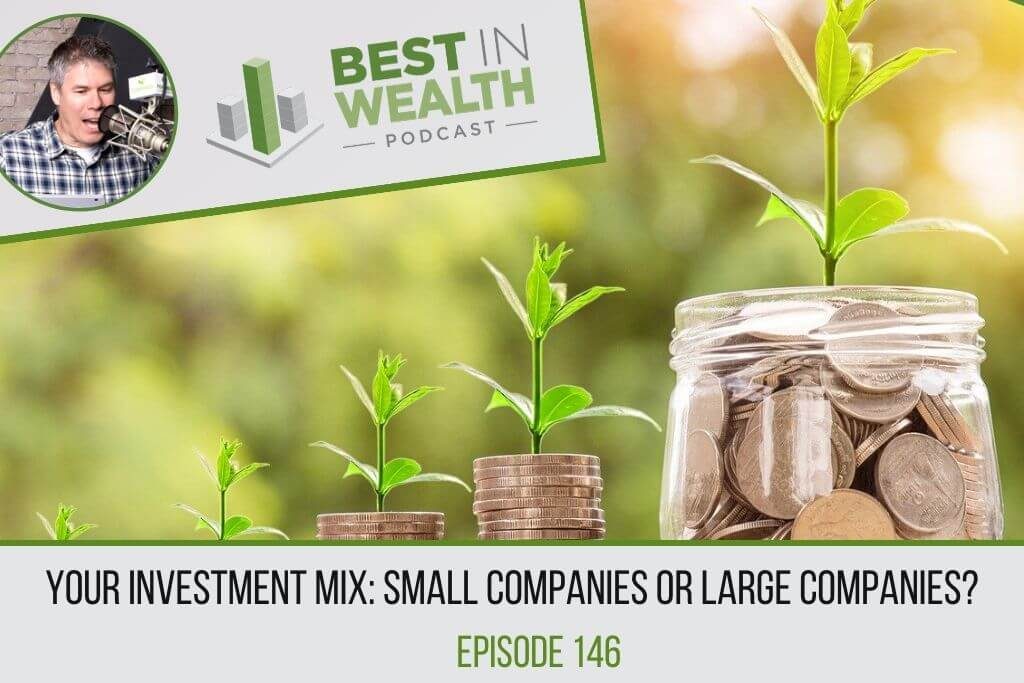Your Investment Mix: Small Companies or Large Companies? Ep #146

Do you have the right investment mix in your portfolio? Does it include a balance of large and small companies? In this episode of Best In Wealth, I talk about the differences between small and large companies, why you would want to own either of them, what the science says, and whether or not you can time when to own a small or large company. If you have considered adding small companies into your investment mix, check out this episode!
What should you have in your investment mix? In this episode of Best in Wealth, I talk about small companies and large companies—and why you should invest in both. #wealth #retirement #investing #PersonalFinance #FinancialPlanning… Click To TweetOutline of This Episode
- [1:19] What’s been going on with the stock market?
- [3:50] Do you have the right investment mix in your portfolio?
- [4:43] Where the stock market stands right now
- [6:31] The definition of what makes a large or small company
- [8:11] Why would I want to own a small company?
- [12:22] Why you should demand a higher rate of return with small
- [14:56] What the science of investment tells us
- [18:34] Why you shouldn’t apply market timing tactics
- [21:05] What the performance of small and large companies tells us
- [22:20] Know what your goals are before you develop your investment plan
What defines a small or large company?
A large company is calculated by taking its outstanding shares and multiplying them by their current stock price. If the resulting number is $10 billion or higher, it is considered a large company. Think brands like Apple, Amazon, Facebook, McDonald’s, etc.
A small company is calculated in the same way—by taking their outstanding shares and multiplying them by their current stock price. However, if the resulting number is between $500 million and around $2 billion, it is considered a small company. These still are not “small” by most people’s definition of small (i.e. a local plumbing company).
Right now, year-to-date, the S&P 500 is only down 3.5% and small companies are down about 15%. Keep listening as we discuss why that is important.
Why your investment mix should include small companies
Let’s say McDonald’s is worth $200 billion. McDonald’s has amazing brand recognition, thousands of locations, and years of positive cash flow. Versus Shake Shack—hypothetically worth around $2 billion, less brand recognition, fewer locations, etc. It makes sense to invest in McDonald’s. After all, the odds of them going belly up are slim-to-none.
About 3% of small companies go out of business in any given year, and up to 6% during economically tough years. But it’s also far easier to take a $2 billion company and double it to $4 billion than to double McDonald’s massive $200 billion empire. Shake Shack is a riskier investment, but as an investor, you can demand a higher rate of return owning Shake Shack vs. McDonald’s.
Why should your investment mix include small companies? I share the details in this episode of Best in Wealth. Don’t miss it! #wealth #retirement #investing #PersonalFinance #FinancialPlanning #RetirementPlanning #WealthManagement Click To TweetWhat does science tell us?
The first key I emphasize when you invest in anything is that it has to make sense. The data has to be persistent and robust and the science has to be pervasive, in the US and around the world. So what does the science tell us?
From 1928 to 2019, large companies average a return on your investment of approximately 9.9% a year. Small companies average a return on investment of 11.94% a year. A 2% difference might seem minuscule, but think about it this way:
If you allot $100,000 to large companies, hold it for 30 years and obtain a 9.9% ROI, you would see a $1.7 million return. If you allot that same $100,000 to small companies, hold it for 30 years, and get the 11.94% return on your investment—you would see a $2.9 million ROI. So that 2% makes a pretty large impact after all!
Can you apply market timing to large and small companies?
I believe market timing is dangerous and does not work in the long run. I do not recommend the strategy, and here’s why: We do not know WHEN small companies will beat out large companies. The percentages are an average of over 90 years—some years small companies perform better and in other years they have a dismal return.
Large companies have performed extremely well in the last 10 years, while small companies have outperformed their average by a minuscule amount. Market timing strategies will give you a stomach-ache and leads to emotional decision making. The longer you hold small companies, the better chance you have of them outperforming large companies and get closer to that 2% premium.
That is why you should have a balanced investment mix of both large and small companies and hold them for the long-term. You will have a much higher probability of seeing a higher expected return for your retirement. Regardless, you should not dive into small or large companies without a plan. You must know your risk capacity, risk tolerance, and required rate of return to develop a plan with the proper investment mix.
To hear my full thoughts and an in-depth explanation of each section, listen to the full episode!
Can you apply market timing to large and small companies? Hear my take in this episode of Best in Wealth! #wealth #retirement #investing #PersonalFinance #FinancialPlanning #RetirementPlanning #WealthManagement Click To TweetResources & People Mentioned
Connect With Scott Wellens
- Schedule a discovery call with Scott
- Send a message to Scott
- Visit Fortress Planning Group
- Connect with Scott on LinkedIn
- Follow Scott on Twitter
- Fortress Planning Group on Facebook
Podcast Disclaimer:
The Best In Wealth Podcast is hosted by Scott Wellens. Scott Wellens is the principal at Fortress Planning Group. Fortress Planning Group is a registered investment advisory firm regulated by the Securities Act of Wisconsin in accordance and compliance with securities laws and regulations. Fortress Planning Group does not render or offer to render personalized investment or tax advice through the Best In Wealth Podcast. The information provided is for informational purposes only and does not constitute financial, tax, investment or legal advice.



